Letter Coding Reasoning: Concepts, Tricks & Solved Examples
Letter Coding: The letter coding-decoding is one of the most important topics of logical reasoning. The English alphabet plays an important role in this topic as the whole topic revolves around the alphabet. The various types of questions of letter coding are asked in almost every competitive and entrance exam. The exams are SSC, RRB, PCS, UPSC, KMAT, CUET, CLAT, VITEEE, MAT, JIPMAT exams etc in which these questions are asked. This article is the most important for the candidates who are preparing for any government or entrance exam.
In this article, we will cover the concept of letter coding, how to solve letter coding questions, letter coding examples and explanations, letter coding reasoning tips and tricks, letter coding tricks and techniques, letter coding with numbers, letter coding reasoning for competitive exams and practice letter coding reasoning questions.
CAT 2024: 20 Free Mock Test | 10 Year PYQs | 60 Day Study Material | Most Scoring Concepts
XAT 2025: Section-wise Preparation Tips | Sample Paper
Don't Miss: IBSAT 2024 Mock Tests | NMAT 2024 Sample Papers | MAT 2024 Sample Papers
Question with Solutions: Missing Number | Alphabet Test | Arithmatical Problems | Calendar
- What is Letter Coding?
- Types of Letter Coding
- How to Solve the Questions of Letter Coding?
- Tips to Tackle Letter Coding Reasoning Questions
- Recommended Books and Online Resources
- Question Weightage of Letter Coding Reasoning Questions in Competitive Exams
- Practice Questions for Letter Coding
- Practice Questions for Number Coding
- Practice Questions for Matrix Coding
- Practice Questions for Chinese Coding
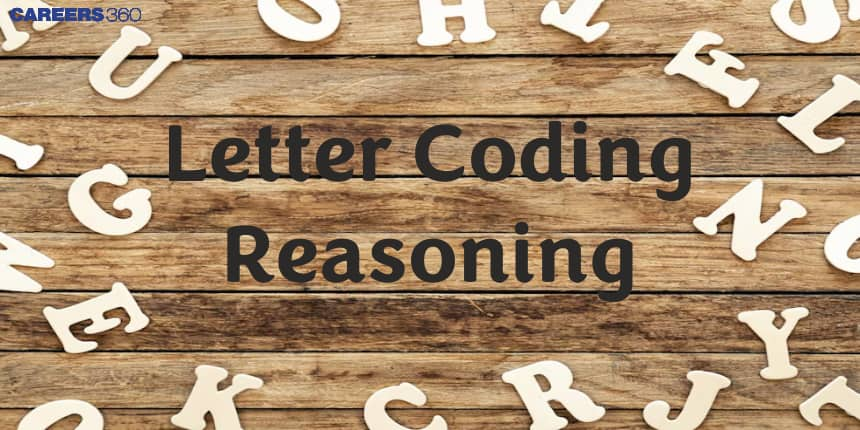
What is Letter Coding?
Letter coding reasoning is defined as the coding of the letters by the letters themselves, numbers, symbols etc by following some specific rules or patterns. The topic letter coding reasoning is based on encoding a letter, a number, or a word. Coding letters, numbers, or words is based on various rules and patterns. The candidates have to decode the correct pattern for the coded letters, numbers or words to solve the questions.
Types of Letter Coding
There are five types of letter coding reasoning which are as follows:
Direct Letter Coding/Letter to Letter Coding
Letter to Number Coding
Letter to Symbol, Number Coding
Chinese Coding
Matrix Coding
Now let’s discuss each type in detail:
1) Direct Letter Coding/Letter to Letter Coding
In this type of coding question, the letters are directly coded as letters with the help of different operations on the positional value of the letters, such as addition, subtraction, etc. Let’s understand this with the help of an example.
Example:
Directions: In a code language, TORCH is written as UNPSDI, and BEST is written as CDFTU. How will MARKS be written in that language?
OZBSMT
NZCSLT
NABSLU
NZBSLT
Hint: The vowel is coded with its previous and next letter and consonants are coded by its next letter as per the alphabetical series.
Solution
Code the vowel with its previous and next letter in the alphabetical series while consonants are coded by their next letter.
For TORCH, to obtain the required code –

Thus, TORCH is coded as UNPSDI.
For BEST –

Thus, BEST is coded as CDFTU.
Similarly, for MARKS –

Thus, MARKS is coded as NZBSLT. Hence, the fourth option is correct.
2) Letter to Number Coding
In this type of coding question, the letters of the given words are coded as numbers with the help of different operations on the place value of the letters, such as addition, subtraction, etc. Let’s understand this with the help of an example.
Example:
Directions: In a certain language, the word CLOCK is written as 4 – 13 – 17 – 4 – 12. How will you write PHONE in the same language?
1) 17 – 10 – 16 – 15 – 6
2) 17 – 9 – 16 – 17 – 6
3) 17 – 9 – 17 – 15 – 6
4) 16 – 9 – 15 – 16 – 5
Hint: Determine the code by using the position values of the letters of a given word.
Solution
Write the position values of the letters of CLOCK, and then add 2 to the position value of O, and add 1 to the position values of the remaining letters to obtain the required code –
C→3; L→12; O→15; C→3; K→11
Now, add 2 to the position value of O, and add 1 to the position values of the remaining letters –
C→3 + 1 = 4; L→12 + 1 = 13; O→15 + 2 = 17; C→3 + 1 = 4; K→11 + 1 = 12
Thus, CLOCK is coded as 4 – 13 – 17 – 4 – 12.
Similarly, follow the same pattern for PHONE –
P→16; H→8; O→15; N→14; E→5
Now, add 2 to the position value of O, and add 1 to the position values of the remaining letters –
P→16 + 1 = 17; H→8 + 1 = 9; O→15 + 2 = 17; N→14 + 1 = 15; E→5 + 1 = 6
So, PHONE is coded as 17 – 9 – 17 – 15 – 6. Hence, the third option is correct.
3) Letter to Symbol, Number Coding
In this type of coding question, the letters of the given words are coded as different types of symbols such @, #, $, %, *, & etc or with numbers. Let’s understand this with the help of an example.
Example:
Directions: If PENCIL is coded as ?@.=;7 and PAPER is coded as ?9?@5, how will you code CLIP?
Solution: Each letter of the word PENCIL is coded with the equivalent symbols and numbers given in the code –
P→?, E→@, N→., C→=, I→;, L→7
Thus, PENCIL is coded as ?@.=;7.
And, PAPER is coded as ?9?@ 5 –
P→?, A→9, P→?, E→@, R→5
All the letters of CLIP are given in PENCIL, therefore, the code for CLIP is→
C →=, L→7, I→;, P→?
So, CLIP is coded as =7;?.
4) Matrix Coding
This type of coding question is based on the matrices. In this type of coding, two matrices are given in the question. In the given matrices, the letters are coded as certain numbers. One letter can have more than one code. Let’s understand this with the help of an example.
Example:
Directions: A word is represented by only one set of numbers as given in any one of the alternatives. The sets of numbers given in the alternatives are represented by two classes of alphabets as in the two matrices, given below. The columns and rows of Matrix (I) are numbered from 0 to 4 and that of Matrix (II) are numbered from 5 to 9. A letter from these matrices can be represented first by its row and next by its column, e.g. A can be represented by 03,10, etc., and P can be represented by 55, 67, etc. Similarly, you have to identify the set for the word REST.
A word is represented by only one set of numbers as given in any one of the alternatives. The sets of numbers given in the alternatives are represented by two classes of alphabets as in the two matrices, given below. The columns and rows of Matrix (I) are numbered from 0 to 4 and that of Matrix (II) are numbered from 5 to 9. A letter from these matrices can be represented first by its row and next by its column, e.g. A can be represented by 03,10, etc., and P can be represented by 55, 67, etc. Similarly, you have to identify the set for the word REST
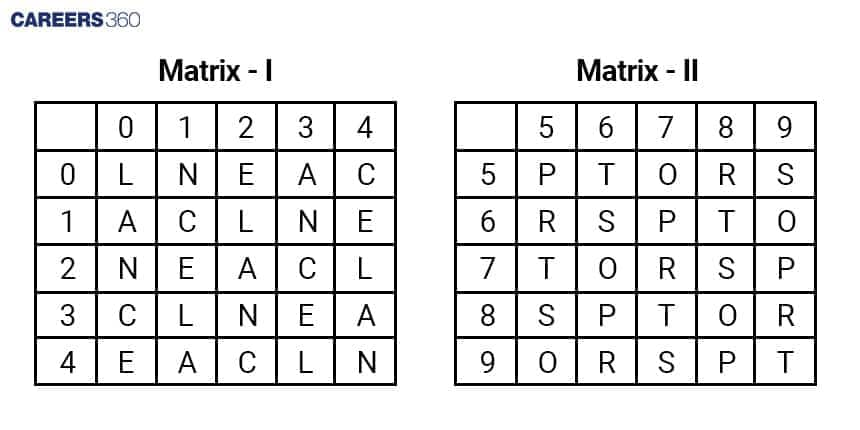
A) 96, 33, 44, 87
B) 58, 21, 85, 75
C) 89, 40, 31, 56
D) 77, 10, 5, 68
Here, from the matrices (Matrix 1 and Matrix 2) we get the numbers that represent the letters of the word REST –
R→58, 65, 77, 89, 96
E→02, 14, 21, 33, 40
S→59, 66, 78, 85, 97
T→56, 68, 75, 87, 99
Therefore, on comparing these numbers with the given alternatives, we get that the word REST is represented by the numbers 58, 21, 85, and 75. Hence, the second option is correct.
5) Chinese Coding
In this type of coding question, a set of a few statements consisting of words, numbers, letters, or symbols in different order are coded as words, symbols, letters, or numbers. The candidates have to find the codes of the given words in the statement by identifying the common words in different statements. The code for the common words will be the same in all the statements. Let’s understand this with the help of an example.
Example:
Directions: In a certain code language, heat is waves is coded as 76@, and waves are dramatic not is coded as 34%7. What can be the code for heat in that language?
1) %
2) 4
3) @
4) 3
Hint: Compare the statements and determine the common words and code.
Solution
From statement 1, we have heat which is only in statement 1 and either 6 or @ is the code for heat.
In options, as we have only @, we can choose the given option.
So, heat is coded as @. Hence, the third option is correct.
How to Solve the Questions of Letter Coding?
To solve the letter coding reasoning questions candidates can follow the below points:
1) Firstly, to master the topic letter coding reasoning or to solve the questions quickly candidates must learn the positional values of the letters in both forward and backward directions and the candidates must know numbers such as odd, even, prime numbers and multiples of numbers.
2) There are a total of 26 letters in the English alphabet of which 5 are vowels (A, E, I, O, U) and 21 are consonants (B, C, D, F, G, H, J, K, L, M, N, P, Q, R, S, T, V, W, X, Y, Z). The candidates must remember this point.
3) The main point of solving the letter coding question is to determine the patterns or rules followed by the given words in the question. To determine the pattern, the candidate must write down the positional values of the word and its code then they will able to identify easily that which operation is used in the question whether it will be addition, subtraction, division, multiples etc.
4) There are some coding rules and patterns to find out the required solution. These rules include:
a) Alphabetical Order of the letters.
b) Reverse alphabetical order of the letters.
c) Numerical Orders or by using mathematical operations such as addition, subtraction, division, multiples etc.
d) Vowels and Consonants in the words or codes.
The candidate has to identify the rule followed by the given word and code in the question to solve the code of the required word. These common rules help the candidates to solve the letter coding reasoning quickly.
Tips to Tackle Letter Coding Reasoning Questions
Tip 1: In English alphabets the group of five letters known as EJOTY will help the candidates to learn or to find nearby letters quickly. The positional value of these five letters is equal to consecutive multiples of 5.
E | J | O | T | Y |
5 | 10 | 15 | 20 | 25 |
Tip 2: To solve letter coding questions first of all candidates must check the positional values of the letters many times simple arithmetic operations have been used to get the required code after that they may check for opposite letters or for interchanging positions of the letters.
Tip 3: To solve the letter-to-number or letter-to-symbol type letter coding questions, the candidates must write down the positional values of each letter given in the word or the code. After that, they may check the position of the positional values of letters are interchanged or at the same position and for the symbols candidates may find the common symbol of each letter. Finally, they must check the mathematical operations like addition, subtraction or multiplication are applied or not.
Tip 4: The candidates must practice several letter coding and decoding reasoning questions to ace the topic. During practice, the candidates can learn how to apply letter coding reasoning shortcut methods to solve the questions quickly. So, practice is the key to success.
Recommended Books and Online Resources
1. A Modern Approach to Verbal & Non-Verbal Reasoning by R.S. Aggarwal
2. SSC Reasoning by Rakesh Yadav
3. The candidates must practice letter coding reasoning pdf, letter coding decoding questions pdf, and letter coding reasoning questions with answers available online for the preparation of the competitive and entrance exams.
Question Weightage of Letter Coding Reasoning Questions in Competitive Exams
The number of questions based on letter coding reasoning varies from exam to exam -
1) Questions asked in SSC exams i.e. SSC MTS, SSC CGL, SSC CHSL, SSC CPO, Steno - 4 to 5 questions.
2) Questions asked in the Railways exam i.e. Group D, NTPC, JE, ALP etc - 2 to 3 questions.
3) Questions asked in Banking exams, Bank PO, Bank Clerk - 3 to 4 questions.
4) Questions asked in the CUET exam - 2 to 3 questions.
Note: The candidates must practice letter coding questions and answers given below as these questions are important from the examination point of view.
Practice Questions for Letter Coding
1) Directions: In a code language, PLACARD is written as TPEYEVH. How will MONSTER be written in that language?
1) PSSOXJV
2) RTSOXIV
3) QSROXIV
4) QSRRXIV
Hint: The difference between the place values of the letter and its code is 4.
Solution
Subtract four from the middle letter of the word and add four in the rest of the other letters.

Thus, PLACARD is coded as TPEYEVH.
Similarly, by following the same pattern for MONSTER –

Thus, MONSTER is coded as QSROXIV. Hence, the third option is correct.
2) Directions: In a code language, TORCH is written as WRUFK. How will WINTER be written in that language?
1) YLQXHU
2) ZLQWHV
3) ZLQWHU
4) ZLPWGU
Hint: The difference between the place values of the letter and its code is 3.
Solution
Add 3 in the position value of the letters of TORCH, to obtain the required code –

Thus, TORCH is coded as WRUFK.
Similarly, follow the same pattern for WINTER –

Thus, WINTER is coded as ZLQWHU. Hence, the third option is correct.
Read More: The list of verbal reasoning topics below.
Practice Questions for Number Coding
1) Directions: In a code language, CLARITY is written as 176. How will FROZEN be written in that language?
1) 160
2) 186
3) 216
4) 168
Hint: Add the positional values of the alphabet and then the sum is multiplied by 2 to obtain the required code.
Solution
The sum of the positional values of the alphabet in a given word is multiplied by 2 to obtain the required code.
CLARITY→C(3) + L(12) + A(1) + R(18) + I(9) + T(20) + Y(25) = 88; 88 × 2 = 176
Similarly, FROZEN→F(7) + R(18) + O(15) + Z(26) + E(5) + N(14) = 84; 84 × 2 = 168
So, FROZEN is coded as 168. Hence, the fourth option is correct.
2) Directions: In a code language, DENT is written as 51, and LOAD is written as 40. How will COST be written in that language?
1) 75
2) 62
3) 65
4) 57
Hint: Determine the sum of the positional value of the letters and add a specific number to it.
Solution
Add 8 to the sum of the positional value of the letters of DENT, to obtain the required code –
(D(4) + E(5) + N(14) + T(20)) + 8 = 43 + 8 = 51
Thus, DENT is coded as 51.
And, LOAD is coded as 40 –
(L(12) + O(15) + A(1) + D(4)) + 8 = 32 + 8 = 40
Thus, LOAD is coded as 40.
Similarly, follow the same pattern for COST –
(C(3) + O(15) + S(19) + T(20)) + 8 = 57 + 8 = 65
Thus, COST is coded as 65. Hence, the third option is correct.
3) Directions: In a certain code language, MADRAS is written as 112 and JAMMU is written as 82. How will PUNJAB be written in that language?
1) 109
2) 104
3) 112
4) 115
Hint: Determine the code by adding the reverse position values of the letters of the given word and then add the total number of letters in the resultant number.
Solution
Add the reverse position values of the letters of the word MADRAS then add the total number of letters in the word to obtain the required code –
M→14; A→26; D→23; R→9; A→26; S→8
Now, add the reverse position values of the word MADRAS then add the total number of letters in the word –
14 + 26 + 23 + 9 + 26 + 8 = 106 + 6 = 112
Thus, MADRAS is coded as 112.
And, JAMMU is written as 82 –
J→17; A→26; M→14; M→14; U→6
Now, add the reverse position values of the word JAMMU then add the total number of letters in the word –
17 + 26 + 14 + 14 + 6 = 77 + 5 = 82
Thus, JAMMU is coded as 82.
Similarly, follow the same pattern for PUNJAB –
P→11; U→6; N→13; J→17; A→26; B→25
Now, add the reverse position values of the word PUNJAB then add the total number of letters in the word –
11 + 6 + 13 + 17 + 26 + 25 = 98 + 6 = 104
So, PUNJAB is coded as 104. Hence, the second option is correct.
4) Directions: In a certain code language, POLISH is written as 89 and CLIP is written as 72. How will CONTROL be written in that language?
1) 89
2) 92
3) 106
4) 99
Hint: Add the opposite position values of the letters of the given words to the total number of letters present in that word.
Solution
The logic here is – The sum of the opposite position values + the total number of letters
POLISH ⇒ P→K = 11; O→L = 12; L→O = 15; I→R = 18; S→H = 8; H→S = 19
The sum of the opposite position values = 11 + 12 + 15 + 18 + 8 + 19 = 83
Total number of letters = 6
The code is 83 + 6 = 89
CLIP ⇒ C→X = 24; L→O = 15; I→R = 18; P→K = 11
The sum of the opposite position values = 24 + 15 + 18 + 11 = 68
Total number of letters = 4
The code is 68 + 4 = 72
Similarly,
CONTROL ⇒ C→X = 24; O→L = 12; N→M = 13; T→G = 7; R→I = 9; O→L = 12; L→O = 15
The sum of the opposite position value = 24 + 12 + 13 + 7 + 9 + 12 + 15 = 92
Total number of letters = 7
The code is 92 + 7 = 99
So, CONTROL is coded as 99. Hence, the fourth option is correct.
5) Directions: In a code language, SPACE is written as 5 – 91 and ROTTEN is written as 6 – 70. How will MEAN be written in that language?
1) 4 – 75
2) 4 – 74
3) 4 – 73
4) 4 – 76
Solution
The first number is equal to the total number of letters and the second number is equal to the sum of the opposite position value of the letters of SPACE, to obtain the required code –
Total number of letters in SPACE = 5
Opposite position value of the letters of SPACE→S = 8(H); P = 11(K); A = 26(Z); C = 24(X); E = 22(V)
The sum of the opposite position values→8 + 11 + 26 + 24 + 22 = 91
Thus, SPACE is coded as 5 – 91.
And, ROTTEN is written as 6 – 70→
Total number of letters in ROTTEN = 6
Opposite position value of the letters ROTTEN→R = 9(I); O = 12(L); T = 7(G); T = 7(G); E = 22(V); N = 13(M)
The sum of the opposite position values→9 + 12 + 7 + 7 + 22 + 13 = 70
Thus, ROTTEN is coded as 6 – 70.
Similarly, follow the same pattern for MEAN→
Total number of letters in MEAN = 4
Opposite position value of the letters MEAN→M = 14(N); E = 22(V); A = 26(Z); N = 13(M)
The sum of the opposite position values→14 + 22 + 26 + 13 = 75
So, MEAN is coded as 4 – 75. Hence, the first option is correct.
Practice Questions for Matrix Coding
Q1. Directions: A word is represented by only one set of numbers as given in any one of the alternatives. The sets of numbers given in the alternatives are represented by two classes of alphabets as in the two matrices, given below. The columns and rows of Matrix (I) are numbered from 0 to 4 and that of Matrix (II) are numbered from 5 to 9. A letter from these matrices can be represented first by its row and next by its column, e.g. P can be represented by 55,69, etc, and L can be represented by 59, 68, etc. Similarly, you have to identify the set for the word, LAPSE.
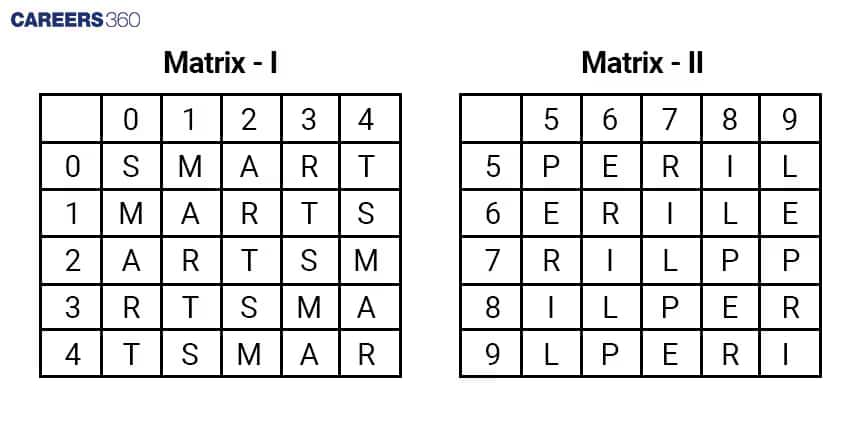
A) 86, 02, 55, 14, 97
B) 86, 57, 00, 41, 97
C) 31, 02, 00, 96, 42
D) 31, 57, 55, 41, 42
Solution:
LAPSE
Number representations of each letter –
L→59, 68, 77, 86, 95
A→02, 11, 20, 34, 43
P→55, 69, 78, 87, 96
S→00, 14, 23, 32, 41
E→56, 65, 79, 88, 97
Let's check the options –
First option: 86, 02, 55, 14, 97 – All the letters of the word LAPSE can be represented through this option.
Second option: 86, 57, 00, 41, 97 – A and P can not be represented as 57 and 00 respectively.
Third option: 31, 02, 00, 96, 42 – L, P, S, and E can not be represented as 31, 00, 96, and 42 respectively.
Fourth option: 31, 57, 55, 41, 42 – L, A, and E can not be represented as 31, 57, and 42 respectively.
So, only the first option consists of the numbers through which LAPSE can be represented. Hence, the first option is correct.
Q2. Directions: A word is represented by only one set of numbers as given in any one of the alternatives. The sets of numbers given in the alternatives are represented by two classes of alphabets as in the two matrices given below. The columns and rows of Matrix (I) are numbered from 0 to 4 and that of Matrix (II) are numbered from 5 to 9. A letter from these matrices can be represented first by its row and next by its column, e.g. C can be represented by 55, 69, etc., and D can be represented by 59, 68, etc. Similarly, you have to identify the set for the word CHILD.
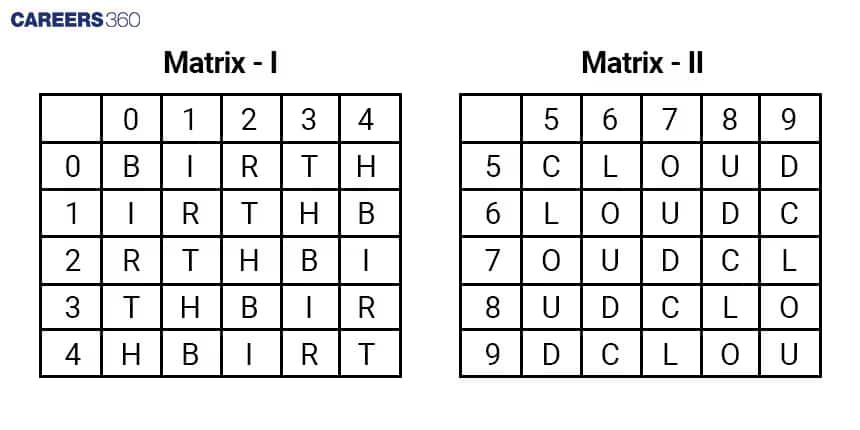
A) 55, 13, 42, 79, 68
B) 96, 22, 97, 24, 13
C) 96, 13, 42, 79, 13
D) 55, 22, 97, 24, 68
Solution:
Number representations of each letter –
C→55, 69, 78, 87, 96
H→04, 13, 22, 31, 40
I→01, 10, 24, 33, 42
L→56, 65, 79, 88, 97
D→59, 68, 77, 86, 95
Let's check the options –
First option: 55, 13, 42, 79, 68 – All the letters of the word CHILD can be represented through this option.
Second option: 96, 22, 97, 24, 13 – I, L, and, D cannot be represented by 97, 24, and, 13 respectively.
Third option: 96, 13, 42, 79, 13 – D cannot be represented by 13.
Fourth option: 55, 22, 97, 24, 68 – I and L cannot be represented by 97 and 24 respectively.
So, only the first option consists of the numbers through which CHILD can be represented. Hence, the first option is correct.
Q3. Directions: A word is represented by only one set of numbers as given in any one of the alternatives. The sets of numbers given in the alternatives are represented by two classes of alphabets as in the two matrices, given below. The columns and rows of Matrix (I) are numbered from 0 to 4 and that of Matrix (II) are numbered from 5 to 9. A letter from these matrices can be represented first by its row and next by its column, e.g. P can be represented by 55, 69, etc, and L can be represented by 59, 68, etc. Similarly, you have to identify the set for the word PEST.
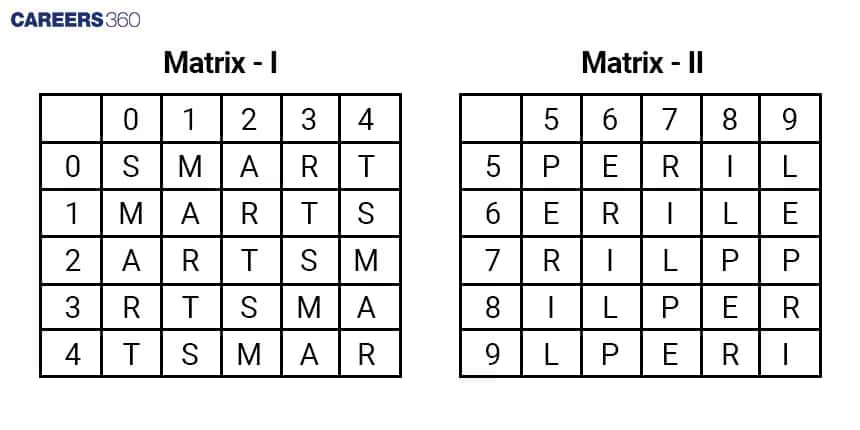
A) 87, 56, 03, 04
B) 55, 79, 23, 22 (Correct)
C) 69, 98, 41, 40
D) 96, 65, 32, 00
Solution:
Let's check the options –
First option: 87, 56, 03, 04 – S cannot be represented by 03.
Second option: 55, 79, 23, 22 – All the letters of the word PEST can be represented through this option.
Third option: 69, 98, 41, 40 – E cannot be represented as 98.
Fourth option: 96, 65, 32, 00 – T cannot be represented as 00.
So, only the second option consists of the numbers through which PEST can be represented. Hence, the second option is correct.
Q4. Directions: A word is represented by only one set of numbers as given in any one of the alternatives. The sets of numbers given in the alternatives are represented by two classes of alphabets as in the two matrices, given below. The columns and rows of Matrix (I) are numbered from 0 to 4 and that of Matrix (II) are numbered from 5 to 9. A letter from these matrices can be represented first by its row and next by its column, e.g. C can be represented by 55, 69, etc, and D can be represented by 59, 68, etc. Similarly, you have to identify the set for the word BLOW.
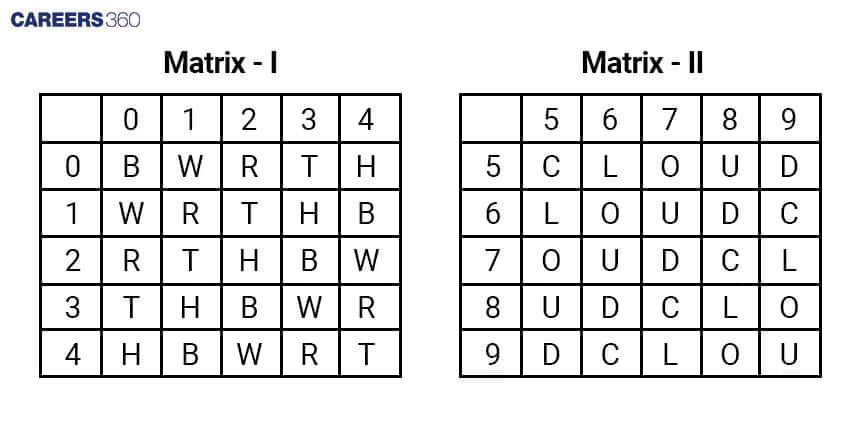
A) 14, 56, 89, 34
B) 00, 65, 67, 10
C) 41, 87, 57, 01
D) 32, 88, 98, 33
Solution:
Let's check the options –
First option: 14, 56, 89, 34 – W cannot be represented by 34.
Second option: 00, 65, 67, 10 – O cannot be represented as 67.
Third option: 41, 87, 57, 01 – L cannot be represented as 87.
Fourth option: 32, 88, 98, 33 – All the letters of the word BLOW can be represented through this option.
So, only the fourth option consists of the numbers through which BLOW can be represented. Hence, the fourth option is correct.
Q5. Directions: A word is represented by only one set of numbers as given in any one of the alternatives. The sets of numbers given in the alternatives are represented by two classes of alphabets as in the two matrices, given below. The columns and rows of Matrix (I) are numbered from 0 to 4 and that of Matrix (II) are numbered from 5 to 9. A letter from these matrices can be represented first by its row and next by its column, e.g. A can be represented by 01, 20, etc, and B can be represented by 56, 65, etc. Similarly, you have to identify the set for the word, CARS.
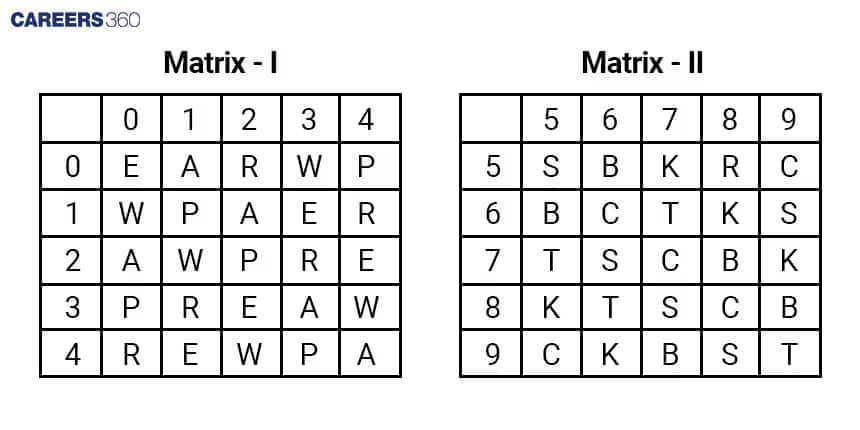
A) 66, 20, 31, 88
B) 77, 33, 40, 69
C) 96, 00, 23, 99
D) 95, 01, 13, 77
Solution:
Number representations of each letter –
C→59, 66, 77, 88, 95
A→20, 01, 12, 33, 44
R→40, 31, 02, 23, 14
S→55, 76, 87, 98, 69
Let's check the options –
First option: 66, 20, 31, 88 – S cannot be represented by 88.
Second option: 77, 33, 40, 69 – All the letters of the word CARS can be represented through this option
Third option: 96, 00, 23, 99 – C, A, and S cannot be represented as 96, 00, and 99 respectively.
Fourth option: 95, 01, 13, 77 – R and S cannot be represented as 13 and 77 respectively.
So, only the second option consists of the numbers through which CARS can be represented. Hence, the second option is correct.
Practice Questions for Chinese Coding
1) Directions: In a certain code language, 629 is coded as namo te fek, 943 is coded as dump to te, and 748 is coded as to fir tako. What is the code for the letter 3 in that language
1) dump
2) to
3) fir
4) te
Hint: Determine the code by comparing the given numbers and words.
Solution
By comparing all the above-coded numbers, we find that –
In sentences 1 and 2, 9 and te are common.
In sentences 2 and 3, 4 and to are common.
The remaining number and the code in sentence 1 are 6/2 and namo/fek; in sentence 2 are 3 and dump; in sentence 3 are 7/8 and fir/tako.
Finally, 9 ⇒ te; 4 ⇒ to; 6/2 ⇒ namo/fek; 3 ⇒ dump
So, 3 will be coded as dump. Hence, the first option is correct.
2) Directions: In a code language, food is fresh is coded as dy in pq, bring fresh food is coded as tq pq dy, and food is hot is coded as dy in to. What is the code for the word fresh?
1) In
2) to
3) pq
4) dy
Hint: Determine the code by comparing the given sentences.
Solution
By comparing all the coded sentences, we find that –
In sentences 1 and 2, food and fresh are common words and pq and dy are common codes.
In sentences 1 and 3, food and is are common words and dy and in are common codes.
The remaining words and code are in sentence 2; bring and tq and in sentence 3; hot and to.
Finally, food ⇒ dy; fresh ⇒ pq; is ⇒ in; bring ⇒ tq; hot ⇒ to
So, fresh will be coded as pq. Hence, the third option is correct.
3) Directions: In a code language, you can start is written as sent room dark, can you read is written as room sent less, and you are good is written as tyre room spin. What is the code for the word can in this language?
1) room
2) sent
3) spin
4) dark
Hint: Compare the statements and determine the common words and code.
Solution
By comparing all the above-coded sentences, we find that –
In sentences 1 and 2, can is the common word and sent is the common code.
In sentences 1, 2 and 3, the common word is you and the common code is room.
The remaining words and codes in sentence 1 are start and dark; in sentence 2 read and less; in sentence 3 are/good and tyre/spin.
Finally, can ⇒ sent; you ⇒ room; start ⇒ room; read ⇒ less; are/good ⇒ tyre/spin
So, can will be coded as sent. Hence, the second option is correct.
4) Directions: In a code language, sign up for sports is written as kri rit vin gab, the sign post fell is written as pri dan rit nei, and the post is closed is written as dan sha fal pri. What is the code for the word fell in this language?
1) pri
2) nei
3) fal
4) rit
Hint: Compare the statements and determine the common words and code.
Solution
By comparing all the above-coded sentences, we find that –
In sentences 1 and 2, the common word is sign and the common code is rit are common.
In sentences 2 and 3, common words are the and post and common codes are pri and dan.
The remaining words and the code in sentence 1 up/for/sports and kri/vin/gab; in sentence 2 fell and nei; in sentence 3 is/closed and sha/fal.
Finally, sign ⇒ rit; the/post ⇒ pri/dan; up/for/sports ⇒ kri/vin/gab; fell ⇒ nei; is/closed ⇒ sha/fal
So, fell will be coded as nei. Hence, the second option is correct.
5) Directions: In a code language, you are tall is coded as la da ma, you workout daily is coded as la pa ka, and daily workout makes you tall is coded as ka pa ja la ma. What is the code for the word makes?
1) ma
2) ja
3) la
4) pa
Hint: Solve the question by comparing the given sentences together.
Solution
By comparing all the three coded sentences, we find that –
In sentences 1, 2, and 3, you and la are common.
In sentences 2 and 3, workout, daily and pa, ka are common.
In sentences 1 and 3, tall and ma are common.
The remaining words and code are in sentence 1; are and da; In sentence 3; makes and ja.
Finally, you ⇒ la; workout ⇒ pa/ka; daily ⇒ pa/ka; tall ⇒ ma; are ⇒ da; makes ⇒ ja.
So, makes is coded as ja. Hence, the second option is correct.
For Non-Verbal reasoning read the topics below:
About the Faculty
Tanu Gupta, with over a decade of experience as a reasoning faculty, specializes in preparing students for various entrance examinations and career development. Her extensive work with multiple educational platforms and institutions has honed her expertise in logical and analytical thinking. Her dedication to innovative teaching methods ensures these articles provide practical insights and expert guidance.
Frequently Asked Questions (FAQs)
Letter coding reasoning is defined as the coding of the letters by the letters themselves, numbers, symbols etc by following some specific rules or patterns. The topic letter coding reasoning is based on encoding a letter, a number, or a word. Coding letters, numbers, or words is based on various rules and patterns. The candidates have to decode the correct pattern for the coded letters, numbers or words to solve the questions.
There are five types of letter coding which are as follows:
1) Direct Letter Coding/Letter to Letter Coding
2) Letter to Number Coding
3) Letter to Symbol, Number Coding
4) Chinese Coding
5) Matrix Coding
To solve letter coding questions the candidates must learn the positional values of the alphabet and have basic knowledge of simple arithmetic operations such as addition, subtraction, multiplication, division, multiples etc. The steps for solving the questions of letter coding are given in the above article in detail.
The example of letter code is given below:
In a certain code language, COURT is written as ERWUV and DANCE is written as FDPFG. How will EARTH be written in that language?
Solution:
Add 2 and 3 alternately to the place value of the letters of COURT to obtain the required code –
C + 2 = E; O + 3 = R; U + 2 = W; R + 3 = U; T + 2 = V
Thus, COURT is coded as ERWUV.
And, DANCE is written as FDPFG.
D + 2 = F; A + 3 = D; N + 2 = P; C + 3 = F; E + 2 = G
Similarly, follow the same pattern for EARTH –
E + 2 = G; A + 3 = D; R + 2 = T; T + 3 = W; H + 2 = J
So, EARTH is coded as GDTWJ.